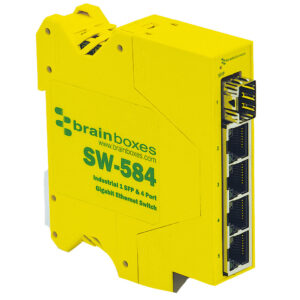Understanding Industrial SFP Fibre Technology in Today’s Automation Market

As digital transformation continues to drive efficiency and productivity across industry, increasing the demand for faster and more reliable data transmission, SFP fibre technology has emerged as a crucial component in industrial networking infrastructure.
While closely related, SFP (Small Form-Factor Pluggable) and fibre are not the same thing. As a transceiver (both transmitter and receiver in a single package), SFP interfaces with networking equipment such as Ethernet switches and PLCs to enable the transmission of data signals.
Where SFP is a specific type of transceiver module, fibre optics refers to the underlying technology; the entire system of transmitting data through optical fibres. Fibre optics offer higher bandwidth, faster speeds, and longer transmission distances compared to traditional copper cables.
SFP is the interface, while fibre optics is the underlying technology

Understanding SFP Fibre Optic Technology
Fibre optics revolutionized the telecommunications industry by utilizing thin strands of glass or plastic to transmit data as pulses of light. This technology offers numerous advantages over traditional copper-based wiring, including higher data transfer speeds, greater bandwidth capacity, immunity to electromagnetic interference, and longer transmission distances.
What is SFP?
SFP, short for Small Form-factor Pluggable, is not a type of fibre optic cable itself, but rather a standardized, hot-pluggable transceiver module that allows for the flexible use of different types of cables. SFP modules are widely used in networking equipment, such as switches, routers, and media converters, to enable connectivity by supporting various optical and electrical interfaces, including Ethernet, Fibre, and SONET/SDH.

Flexibility and Interchangeability
One of the key benefits of industrial SFP modules is their ability to support various types of cables depending on the specific requirements of the application. This flexibility allows organizations to adapt their network infrastructure to different scenarios without replacing entire systems. By simply swapping out the SFP modules, businesses can easily reconfigure their networks to accommodate changes in distance, bandwidth, or transmission technology.
Hot-Pluggable
SFP fibre modules are hot-pluggable, meaning they can be inserted or removed from network devices without the need for powering down or interrupting the entire system. This feature provides immense convenience and flexibility in maintaining and expanding network infrastructure, minimizing downtime and enhancing overall system reliability.
Upgradability and Scalability
As technology evolves and network requirements change, SFP modules enable organisations to upgrade their network capabilities by simply replacing or adding compatible modules. This scalability allows businesses to adapt to growing demands without significant investments in new equipment, ultimately reducing costs and improving network performance.
 The Role of SFP Fibre in Industrial Automation
The Role of SFP Fibre in Industrial Automation
SFP fibre modules are essential components for establishing reliable and high-speed communication networks. They offer the flexibility to connect industrial devices, such as programmable logic controllers (PLCs), industrial Ethernet switches, and other automation equipment, to fibre optic networks, enabling efficient data transfer, remote monitoring and control.
Brainboxes have just developed a new range of industrial SFP and Gigabit Ethernet Switches; designed to be the perfect fit for industrial applications where more network throughput is key. The robust design of the devices offers enhanced reliability and a simple, low-cost way to deploy long network segments. By leveraging the flexibility, interchangeability, hot-pluggable nature, and scalability of SFP fibre, businesses can optimize their network infrastructure today, and futureproof for the demands of tomorrow’s industrial automation market.
For further reading see: SFP – Complete guide to Small Form-Factor Pluggable – 7 things you need to know
